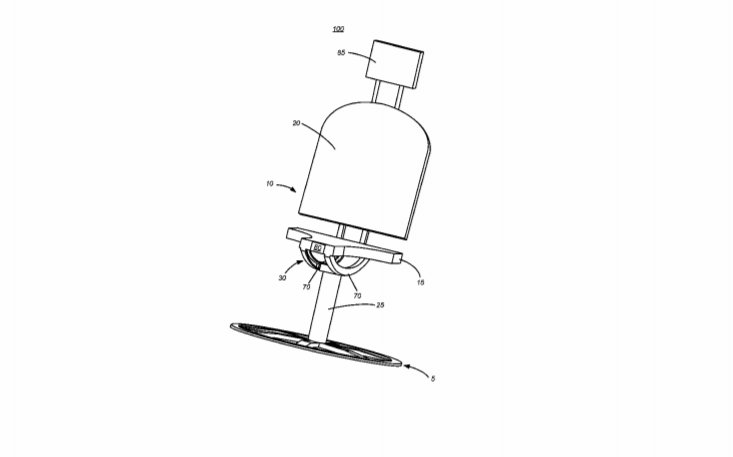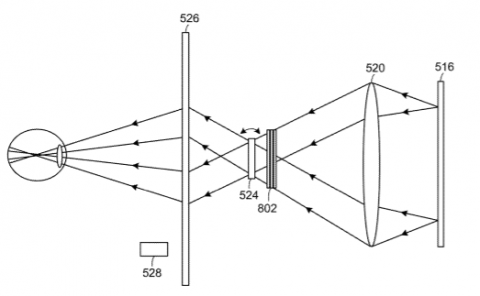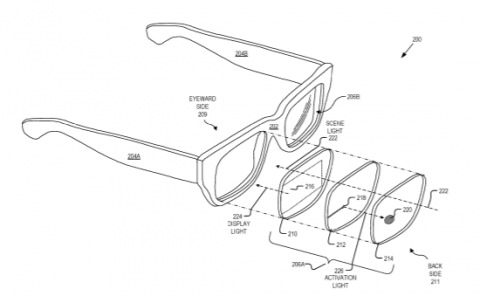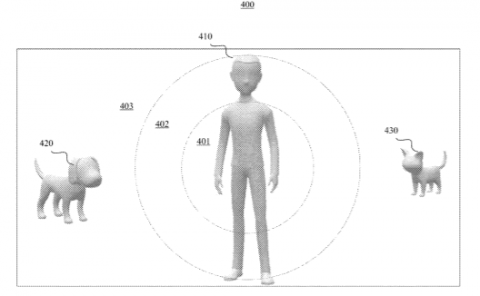Oculus Patent | Navigation controller for virtual-reality systems
Patent: Navigation controller for virtual-reality systems
Publication Number: 10163360
Publication Date: 2018-12-25
Applicants: OCULUS VR, LLC

Abstract
A virtual-reality navigation controller includes a base and a seating portion. The seating portion includes a seat for supporting a weight of a user seated thereon, and a back-rest coupled to the seat to move integrally with the seat and to support the user’s back. The virtual-reality navigation controller further includes a displacement connector between the seating portion and the base to reciprocate the seating portion upwards and downwards, and a motion-detection controller to measure upwards and downwards displacement of the seating portion. The displacement connector is configured to move the seating portion upwards along with the user to support the user when the user ascends from the seat during virtual-reality activities. The displacement connector is further configured to move the seating portion downwards at a slower maximum speed than the upwards movement, when the user’s body rests back on the seat.
Background
TECHNICAL FIELD
This disclosure relates generally to gaming entertainment and virtual-reality systems, and more specifically to a navigation controller for simulation of pitch, yaw, and/or vertical motion for use in such gaming entertainment and virtual-reality systems while providing vestibular (balance), somatosensory (skin), and proprioceptive (muscle) sensations to accompany the visually experienced acceleration in real life and prevent simulator (motion) sickness.
BACKGROUND
Virtual-reality simulation systems are becoming increasingly popular for applications such as video gaming and operator skill and developmental training. Such virtual-reality simulation systems are generally designed to mimic an object environment for a targeted application. For example, video simulators have been proposed for simulating the dynamics of aircraft, marine vessels, locomotives and automobiles. In each of these examples, the objective of the video simulation system is to mimic visual and motion characteristics of an environment associated with operation of the object under simulated conditions.
It is important to accurately simulate the dynamics of an object environment, especially where the associated application is training, for example flight operator training. The operator’s experience within the simulator should closely resemble real-world conditions in order to build adequate experience, skill and to anticipate reactions of the operator in preparation for a real-world event or condition.
Currently available systems have yet to provide a cost-effective and adequate motion simulation platform. To be cost effective, it would be beneficial to provide such a platform with relatively few moving components and a reasonable size. There is a need in the art to overcome the challenges of providing fewer mechanical parts while maintaining adequate motion simulation. Thus, there is an ongoing need for improved motion platforms for use with video virtual-reality simulation systems, especially such platforms configured for low cost, simple and effective mechanical motion simulation.
Summary
Disclosed motion simulation provides vestibular (balance), somatosensory (skin), and proprioceptive (muscle) sensations or stimulation during active (self-initiated) virtual-reality navigation, which accompanies visually experienced sensations in reality. For example, vertical motion, yaw motion about a vertical axis, and/or pitch motion corresponding to tilting of the navigation controller are used to simulate motion with acceleration in virtual-reality, while providing appropriate vestibular (balance), proprioceptive (muscle) and somatosensory (skin) stimulation to accompany the visually experienced acceleration and prevent simulator sickness, which is similar to motion sickness.
In accordance with some embodiments, a virtual-reality navigation controller includes a base and a seating portion. The seating portion includes a seat for supporting a weight of a user seated thereon and a back-rest coupled to the seat to move integrally with the seat and to support the user’s back. The virtual-reality navigation controller further includes a displacement connector between the seating portion and the base to reciprocate the seating portion upwards and downwards, and a motion-detection controller to measure upwards and downwards displacement of the seating portion. The displacement connector is configured to move the seating portion upwards along with the user to support the user when the user ascends from the seat during virtual-reality activities. The displacement connector is further configured to move the seating portion downwards at a slower maximum speed than the upwards movement, when the user’s body rests back on the seat.
In some embodiments, the displacement connector includes a cylindrical housing sealably containing a compressible fluid therein, a piston rod reciprocally disposed in the housing, and a piston mounted on the piston rod and disposed to reciprocate upwards and downwards along inner walls of the housing. The displacement connector further includes at least one check-valve configured to increase an amount of flow of the compressible fluid past the piston in a first direction to accelerate the piston and the seating portion upwards and configured to restrict the amount of flow of the compressible fluid past the piston in a second direction to decelerate the piston and the seating portion downwards.
In some embodiments, the displacement connector forms a spring-loaded connection, and the compressible fluid is nitrogen gas.
In some embodiments, the at least one check-valve includes first and second check-valves. The first check-valve is disposed in an open condition and the second check-valve is disposed in a closed condition when the piston rod is extended upwards from the housing for the compressible fluid to travel through the first check-valve and allow the piston to move the seating portion upwards at a first speed matching that of the user’s ascent. The first check-valve is disposed in a closed condition and the second check-valve is disposed in an open condition when the piston rod retracts into the housing for the compressible fluid to travel through the second check-valve and allow the piston to move the seating portion downwards at a second speed. The first check-valve has a larger flow cross-section area than the second check-valve, and a maximum value of the first speed is greater than a maximum value of the second speed.
In some embodiments, the at least one check-valve is a ball check-valve or a flap check-valve.
In some embodiments, the at least one check-valve is spring-loaded to keep the check-valve in a closed position.
In some embodiments, the at least one check-valve is disposed in the piston.
In some embodiments, the displacement connector further includes a lubricant contained in the cylindrical housing to lubricate the piston as the piston reciprocates in the upwards and downwards directions, and a seal to contain the compressible fluid and the lubricant in the housing and prevent leakage thereof.
In some embodiments, the lubricant is an oily substance to reduce friction as the piston reciprocates in the upwards and downwards directions.
In some embodiments, the seat extends lengthwise along a horizontal axis from a proximal end to a distal end, at least a portion of a length of the seat on both left and right sides being concavely curved toward a center axis along the length of the seat to narrow the seat toward the distal end and to accommodate legs of the user.
In some embodiments, the motion-detection controller is communicatively coupleable to a virtual-reality device to initiate corresponding upwards and downwards motions in virtual reality.
In some embodiments, the motion-detection controller is coupled to the seating portion.
In some embodiments, the seating portion is rotatably coupled to the displacement connector to be rotatable about a vertical axis of the displacement connector. The motion-detection controller is configured to measure yaw rotation of the seating portion about the vertical axis of the displacement connector and communicate the yaw rotation to a virtual-reality device to initiate corresponding rotation in virtual-reality.
In some embodiments, the virtual-reality navigation controller further includes a head-rest to support a head of the user and the motion-detection controller is coupled to the head-rest.
In some embodiments, the base includes wheels which are configurable to be locked during the movement of the seating portion and freely rotatable when the seating portion is configured for use as a chair during non-virtual-reality activities. The displacement connector is configured to lock the seating portion into a desired configuration for use as a chair during the non-virtual-reality activities.
In accordance with some embodiments, a virtual-reality navigation controller includes a base and a seating portion. The seating portion includes a seat for supporting a weight of a user seated thereon, and a back-rest coupled to the seat to move integrally with the seat and to support the user’s back. The virtual-reality navigation controller includes a displacement connector between the seating portion and the base. The displacement connector includes a cylindrical housing sealably containing a compressible fluid therein, a piston rod reciprocally disposed in the housing, and a piston mounted on the piston rod and disposed to reciprocate upwards and downwards along inner walls of the housing. The displacement connector further includes at least one check-valve configured to increase an amount of flow of the compressible fluid past the piston in a first direction to accelerate the piston and the seating portion upwards and configured to restrict the amount of flow of the compressible fluid past the piston in a second direction to decelerate the piston and the seating portion downwards. The displacement connector further includes a lubricant contained in the cylindrical housing to lubricate the piston as the piston reciprocates upwards and downwards, and a seal to contain the compressible fluid and the lubricant in the housing and prevent leakage thereof. The virtual-reality navigation controller further includes a motion-detection controller to measure upwards and downwards displacement of the seating portion. The motion-detection controller is communicatively coupleable to a virtual-reality device to initiate corresponding upwards and downwards motions in virtual reality.
In some embodiments, the seating portion is rotatably coupled to the displacement connector to be rotatable about a vertical axis of the displacement connector. The motion-detection controller is further configured to measure yaw rotation of the seating portion about the vertical axis of the displacement connector and communicate the yaw rotation to the virtual-reality device to initiate corresponding rotation in the virtual reality.
In some embodiments, the motion-detection controller is coupled to the seating portion.
In some embodiments, the seat extends lengthwise along a horizontal axis from a proximal end to a distal end. At least a portion of a length of the seat on both left and right sides is concavely curved toward a center axis along the length of the seat to narrow the seat toward the distal end and to better accommodate legs of the user during yaw, tilt, and vertical chair movements.



